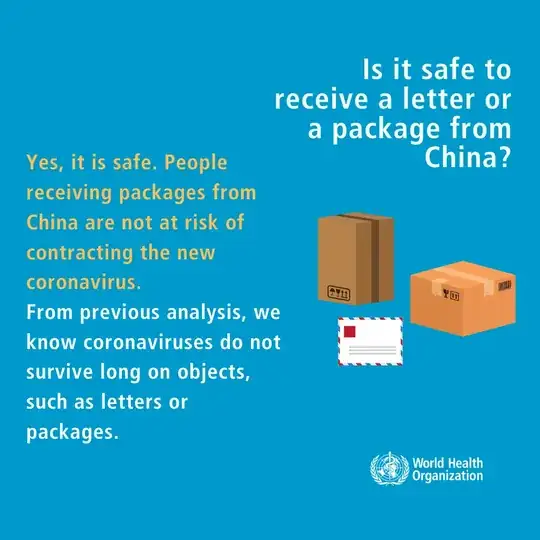The World Health Organisation (WHO) has stated that is 'safe' to receive packages from China.
e.g. from their Facebook page
Is it safe to receive a letter or package from China?
Yes, it is safe. People receiving packages from China are not at risk of contracting the new coronavirus. From previous analysis, we know coronaviruses do not survive long on objects, such as letters or packages.
No citation is provided.
Doing some quick searches on coronavirus survivability, I found a recent paper titled Persistence of coronaviruses on inanimate surfaces and its inactivation with biocidal agents
It contains a table of the persistence of coronavirus on various surfaces.
In summary, the survivability of SARS is 4-5 days on metal and paper.
SARS is another coronavirus, and I believe the RNA sequence is 80% identical to 2019-nCov. Similar survivability could be expected.
Most of the tests in the above paper were carried out at room temperature. However it states that TGEV, another coronavirus, can last 28 days at 4°C.
A higher temperature such as 30°C or 40°C reduced the duration of persistence of highly pathogenic MERS-CoV, TGEV and MHV. However, at 4°C persistence of TGEV and MHV can be increased to ≥ 28 days
This appears to contradict the WHO claim.
Listed below are some examples of expedited international delivery from China to various countries.
USA
- Fedex International Priority: 3.2 days.
- UPS Expedited: 3.9 days
Japan: 3 days
Australia: 3 days
UK: 5 days
I do believe that most packages received from China will be safe but is the WHO ignoring the possibility of risk in the following scenarios:
You live in a country in the vicinity of China with delivery times < 5 days
You live in China and you open a package that was sent in the last 5 days.
You open a package sent from China by express delivery.
UPDATE further references:
"SARS-CoV retained its infectivity for up to 9 days" Stability and inactivation of SARS coronavirus - Rabenau HF
"enveloped viruses, including H1N1 and human coronaviruses, remain infectious on surfaces after several days" Survival of Enveloped and Non-Enveloped Viruses on Inanimate Surfaces
